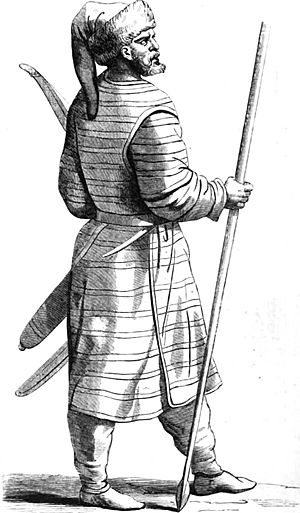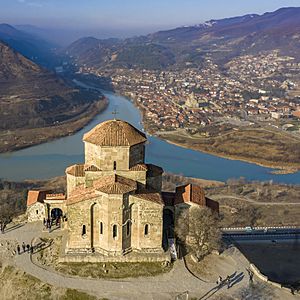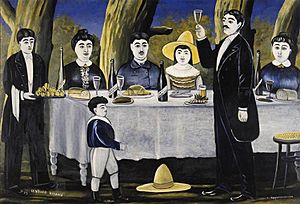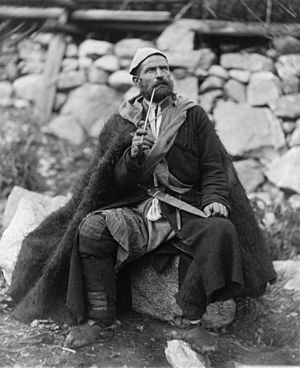Georgians facts for kids
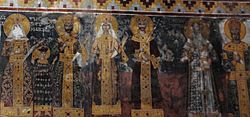
Georgian kings, queens, and the leader of the Georgian Orthodox Church shown in a Byzantine-style fresco at Gelati Monastery, a UNESCO World Heritage Site.
|
|
| Total population | |
|---|---|
| c. 4 million | |
| Regions with significant populations | |
For more, see list of population and statistical data |
|
| Languages | |
| Georgian and other Kartvelian languages | |
| Religion | |
| Predominant: Significant: |
The Georgians, also called Kartvelians (ქართველები, Kartvelebi), are a group of people who originally come from Georgia and the South Caucasus region. They are an ethnic group native to this area. You can also find large Georgian communities in places like Russia, Turkey, Greece, Iran, Ukraine, the United States, and countries in the European Union.
Georgians developed from ancient groups like the Colchians and Iberians. Colchis was connected to Ancient Greek culture. Iberia was influenced by the Achaemenid Empire until Alexander the Great conquered it. In the 4th century, Georgians were among the first to become Christians. Today, most Georgians are Orthodox Christians and belong to the Georgian Orthodox Church. There are also smaller groups of Georgian Catholics and Muslims. Some Georgians do not follow any religion.
Georgia is located in the Caucasus mountains, where Europe and Asia meet. In the High Middle Ages, around 1008 AD, the Georgian people formed a unified kingdom. This kingdom grew into a large empire across the Caucasus. It then entered the Georgian Golden Age, a time when Georgia was very powerful and had a rich culture. This golden age ended when the kingdom became weak and broke apart. This happened because of invasions by the Mongols and Timur between the 13th and 15th centuries. Other reasons included the Black Death plague and the Fall of Constantinople. Internal disagreements after the death of King George V in 1346 also played a part.
After this, during the early modern period, Georgians were divided and ruled by the Ottoman Empire and different Persian empires. Georgians looked for new friends and saw Russia as a possible ally. They hoped Russia would help them because of their shared Christian faith. Georgian kings and Russian tsars sent many messages to each other. This led to an alliance in 1783 between King Heraclius II of eastern Georgia (Kartli-Kakheti) and the Russian Empire.
However, this alliance did not work out as planned. Russia did not keep its promises. Instead, Russia took over Kartli-Kakheti in 1801 and the western Georgian kingdom of Imereti in 1810. Georgians tried several times to regain their independence. A notable attempt was the 1832 plot, but it failed. Eventually, other countries recognized Russia's rule over Georgia. Russia slowly took control of the remaining Georgian lands throughout the 19th century. Georgians briefly became independent again as the First Georgian Republic from 1918 to 1921. Finally, in 1991, they gained full independence from the Soviet Union.
The Georgian nation is made up of many different groups. Each group has its own traditions, customs, and dialects. Some groups, like the Svans and Mingrelians, even have their own regional languages. The Georgian language has its own unique writing system, called the Georgian script. It has a long history of written works, going back to the 5th century. Georgian is the official language of Georgia. It is also the language used for education for all Georgians living in the country. Unofficial numbers suggest there are more than 5 million Georgians around the world.
Contents
What Does "Georgian" Mean?
Georgians call themselves Kartvelebi (ქართველები). They call their land Sakartvelo (საქართველო). Their language is called Kartuli (ქართული). According to old Georgian stories, the ancestor of the Kartvelian people was Kartlos. He was the great-grandson of Japheth from the Bible. However, experts believe the word comes from the Karts. These were one of the early Georgian tribes that became important long ago. Kart might be related to an old word meaning "fortified citadel" or "people who live in a fort."
Ancient Greeks like Homer and Herodotus called western Georgians Colchians. Romans like Titus Livius called eastern Georgians Iberians.
The name "Georgians" comes from the country's name, Georgia. In the past, some travelers had ideas about where the name came from. A French traveler named Jacques de Vitry thought it came from the popularity of Saint George among Georgians. Another traveler, Jean Chardin, thought "Georgia" came from a Greek word meaning "tiller of the land." He thought this because Greeks saw advanced farming when they came to the region.
However, most scholars today disagree with these ideas. They believe the word comes from the Persian word gurğ/gurğān, which means "wolf." This Persian word was then used in many other languages, including Slavic and West European ones. This term might have come from an ancient Iranian name for the area near the Caspian Sea. This region was called Gorgan, meaning "land of the wolves."
Georgian People: A Look at Their Traits
The German professor Johann Friedrich Blumenbach lived in the 1700s. He is known as one of the founders of anthropology, the study of humans. He believed Georgians were the most beautiful people.
The Caucasian variety – I have taken the name of this variety from Mount Caucasus, both because its neighborhood, and especially its southern slope, produces the most beautiful race of men, I mean the Georgian; and because all physiological reasons converge to this, that in that region, if anywhere, it seems we ought with the greatest probability to place the autochthones (original members) of mankind.
A Brief History of Georgians
Most historians and experts agree that the ancestors of modern Georgians lived in the southern Caucasus and northern Anatolia since the Neolithic period, or New Stone Age. These early groups are often called Proto-Kartvelian tribes. This includes groups like the Colchians and Iberians.
The Georgian people were known to the ancient Greeks and Romans as Colchians and Iberians. Eastern Georgian tribes, like the Tibarenians-Iberians, formed their kingdom around the 7th century BCE. However, western Georgian tribes, the Colchians, created the first Georgian state called Colchis around 1350 BCE. This was before the Kingdom of Iberia was founded in the east. Many scholars believe that the creation of these two early Georgian kingdoms, Colchis and Iberia, helped unite the Georgian nation.
According to Cyril Toumanoff, a famous expert on the Caucasus, the Moschians were also an early Georgian tribe. They became part of the first early Georgian state of Iberia. An ancient Jewish record by Josephus mentions Georgians as Iberes, also called Thobel (Tubal). David Marshall Lang suggested that the name Tibar led to Iber, which is why the Greeks called eastern Georgians Iberians.
The Diauehi (mentioned in Assyrian writings) and Taochi (mentioned in Greek writings) lived in northeastern Anatolia. Many scholars believe these ancient tribes were ancestors of Georgians. Modern Georgians still call this region, which is now part of Turkey, Tao-Klarjeti. This was an ancient Georgian kingdom. Some people there still speak Georgian.
Colchians were another early Georgian tribe in the ancient western Georgian state of Colchis. They are first mentioned in old records from Assyrian kings like Tiglath-Pileser I. They also appear in records of the Urartian king Sarduri II. This group also included the western Georgian tribe of the Meskhetians.
Iberians, also known as Tiberians or Tiberanians, lived in the eastern Georgian kingdom of Iberia. Both Colchians and Iberians were very important in forming the Georgian nation and its culture.
Cyril Toumanoff, a scholar of the Caucasus, said:
Colchis appears as the first Caucasian State to have achieved the coalescence of the newcomer, Colchis can be justly regarded as not a proto-Georgian, but a Georgian (West Georgian) kingdom ... It would seem natural to seek the beginnings of Georgian social history in Colchis, the earliest Georgian formation.
Georgian Genetics
A study of human genetics from 2009 showed that Georgians have the highest percentage of Haplogroup G (35.3%) among any general population studied. Georgians' Y-DNA also includes Haplogroup J2 (31.8%), Haplogroup R1a (10.6%), and Haplogroup R1b (9.1%). These are groups of genes passed down through the male line.
Georgian Culture

Language and Its Varieties
Georgian is the main language for Georgians, even for those who speak other Kartvelian languages. These include the languages of the Svans, Mingrelians, and Laz. The Georgian language we know today comes from the eastern part of the country. It spread across most of Georgia after Christianity became central in the first thousand years AD. Today, all Georgians use Georgian as their official language, no matter where their families are from.
The regional languages Svan and Mingrelian were traditionally spoken in the western Kingdom of Colchis before Christianity. But they became less important when the unified Kingdom of Georgia was formed. This is largely because the capital of the unified kingdom, Tbilisi, was in the eastern part of the country, known as the Kingdom of Iberia. This made the eastern language the official language of the Georgian kings.
All these languages belong to the Kartvelian language family. This family also includes the related language of the Laz people, which is spoken in both Turkey and Georgia.
Georgian has many different Georgian dialects. Some examples are Imeretian, Racha-Lechkhumian, Gurian, Adjarian, Imerkhevian (in Turkey), Kartlian, Kakhetian, Ingilo (in Azerbaijan), Tush, Khevsur, Mokhevian, Pshavian, Fereydan (spoken by Georgians in Iran), Mtiuletian, Meskhetian, and Javakhetian.
Religion in Georgia
According to Christian tradition, Christianity was first taught in Georgia by the Apostles Simon and Andrew in the 1st century. It became the official religion of Kartli (Iberia) in 337 AD. At the same time, in the early centuries AD, other beliefs were common in Georgia. These included the worship of Mithras, old pagan beliefs, and Zoroastrianism. The conversion of Kartli to Christianity is credited to St. Nino of Cappadocia. Christianity slowly replaced all other religions except Zoroastrianism. Zoroastrianism became a second official religion in Iberia after a peace treaty in 378 AD.
Becoming Christian placed Georgians in a constant conflict between the Islamic and Christian worlds. Georgians mostly remained Christian, even though Muslim powers invaded many times and ruled for long periods.
Like in other places, the Christian church in Georgia was very important for developing a written language. Most of the earliest written works were religious texts. Medieval Georgian culture was greatly shaped by Eastern Orthodoxy and the Georgian Orthodox Church. The church encouraged and often paid for many religious works. These included churches and monasteries, artworks like icons, and stories about Georgian saints (called hagiographies).
Today, about 83.9% of Georgia's population, mostly ethnic Georgians, follow Eastern Orthodox Christianity. A significant number of Georgian Muslims live in Adjara. This autonomous region borders Turkey and was part of the Ottoman Empire for a longer time than other parts of Georgia. These Georgian Muslims practice the Sunni Hanafi form of Islam. However, the number of Muslims in Adjara decreased during the 20th century. This was due to Soviet anti-religious rules, mixing with the Orthodox majority, and efforts by the Georgian Orthodox Church. Islam remains a strong identity mainly in the eastern, rural areas of Adjara. In earlier times, converted Georgian soldiers were often used by the Persian and Ottoman Empires in special military groups like the Mameluks, Qizilbash, and ghulams. Today, the Georgians in Iran are reportedly all Shia Muslims. The Georgian minority in Turkey are mostly Sunni Muslim.
There is also a small group of Georgian Jews. Their ancestors trace back to the Babylonian captivity.
Besides traditional religions, Georgia also has people who are not religious. There are also many people who say they are religious but do not actively practice their faith.
Georgian Food and Feasts
Georgian cuisine is unique to the country. However, it also has some influences from other European and Western Asian food traditions. Each historical region of Georgia has its own special cooking style. Examples include Megrelian, Kakhetian, and Imeretian cuisines. Besides various meat dishes, Georgian food also offers many vegetarian options.
Food and drink are very important to Georgian culture. You can see this best during a Georgian feast, or supra. A huge variety of dishes are prepared, always with lots of wine. These dinners can last for many hours. In a Georgian feast, the role of the tamada (toastmaster) is very important and respected.
In countries that were once part of the Soviet Union, Georgian food is popular. This is because Georgians moved to other Soviet republics, especially Russia. In Russia, all major cities have many Georgian restaurants. Russian restaurants often include Georgian dishes on their menus.
Georgian Subgroups and Regions
Geographical Subdivisions
Georgians have historically been divided into different subgroups. These groups are based on the region where their ancestors traditionally lived.
Even if someone from one of these subgroups moves to a different region, they are still known by the name of their ancestral region. For example, if a Gurian moves to Tbilisi (which is in the Kartli region), they will not automatically call themselves a Kartlian. This might change if they live there for a very long time. For instance, some Mingrelians have lived in the Imereti region for centuries. Now, they are identified as Imeretian or Imeretian-Mingrelians.
Last names from mountainous eastern Georgian regions often end with –uri (ური) or –uli (ული). Most Svan last names usually end in –ani (ანი). Mingrelian last names often end in –ia (ია), -ua (უა), or -ava (ავა). Laz last names typically end in –shi (ში).
| Name | Name in Georgian | Geographical region | Dialect or Language |
|---|---|---|---|
| Adjarians | აჭარელი achareli | Adjara | Adjarian dialect |
| Gurians | გურული guruli | Guria | Gurian dialect |
| Imeretians | იმერელი imereli | Imereti | Imeretian dialect |
| Javakhians | ჯავახი javakhi | Javakheti | Javakhian dialect |
| Kakhetians | კახელი kakheli | Kakheti | Kakhetian dialect |
| Kartlians | ქართლელი kartleli | Kartli | Kartlian dialect |
| Khevsurians | ხევსური khevsuri | Khevsureti | Khevsurian dialect |
| Lechkhumians | ლეჩხუმელი lechkhumeli | Lechkhumi | Lechkhumian dialect |
| Mingrelians | მეგრელი megreli | Samegrelo | Mingrelian language |
| Meskhetians | მესხი meskhi | Meskheti (Samtskhe) | Meskhian dialect |
| Mokhevians | მოხევე mokheve | Khevi | Mokhevian dialect |
| Pshavians | ფშაველი pshaveli | Pshavi | Pshavian dialect |
| Rachians | რაჭველი rachveli | Racha | Rachian dialect |
| Svans | სვანი svani | Svaneti | Svan language |
| Tushs (Chagma) | თუში tushi | Tusheti | Tushetian dialect |
The 1897 Russian census counted Imeretian, Svan, and Mingrelian languages separately from Georgian. During the 1926 Soviet census, Svans and Mingrelians were also counted separately from Georgians. Svan and Mingrelian languages are both Kartvelian languages and are closely related to the national Georgian language.
Georgian Groups Outside Modern Georgia
Laz people can also be considered Georgian based on where they live and their religion. According to an anthropologist from the London School of Economics, Laz people living in Georgia often call themselves "first-class Georgians." They do this to show pride. They see their Muslim relatives in Turkey as "Turkified Lazs," meaning they have adopted Turkish culture.
| Subethnic groups | Georgian name | Settlement area | Language (dialect) |
Number | Difference(s) from mainstream Georgians (other than location) |
|---|---|---|---|---|---|
| Laz people | ლაზი lazi | Chaneti (Turkey) | Laz language | 1 million | Religion: Mostly Muslim, some Orthodox |
| Fereydani | ფერეიდანი Pereidani | Fereydan (Iran) | Pereidnuli dialect | 100,000 + | Religion: Muslim |
| Chveneburi | ჩვენებური chveneburi | Black Sea Region (Turkey) | Georgian language | 91,000–1,000,000 | Religion: Muslim |
| Ingiloy people | ინგილო ingilo | Saingilo Hereti Zaqatala District (Azerbaijan) | Ingiloan dialect | 12,000 | Religion: Mostly Muslim, some Orthodox |
| Imerkhevians
(Shavshians) |
შავში shavshi | Shavsheti (Turkey) | Imerkhevian dialect | Religion: Mostly Muslim. | |
| Klarjians | კლარჯი klarji | Klarjeti (Turkey) | Imerkhevian dialect |
Extinct Georgian Subdivisions
Throughout history, Georgia has also had Georgian subgroups that no longer exist.
| Name | Name in Georgian | Geographical location | Dialect or language |
|---|---|---|---|
| Dvals | დვალები dvalebi | Russian Federation North Ossetia | Dval dialect |
Images for kids
-
Saint George fighting the dragon. The name "Georgia" was once thought to come from this saint.
See also
 In Spanish: Georgianos para niños
In Spanish: Georgianos para niños


